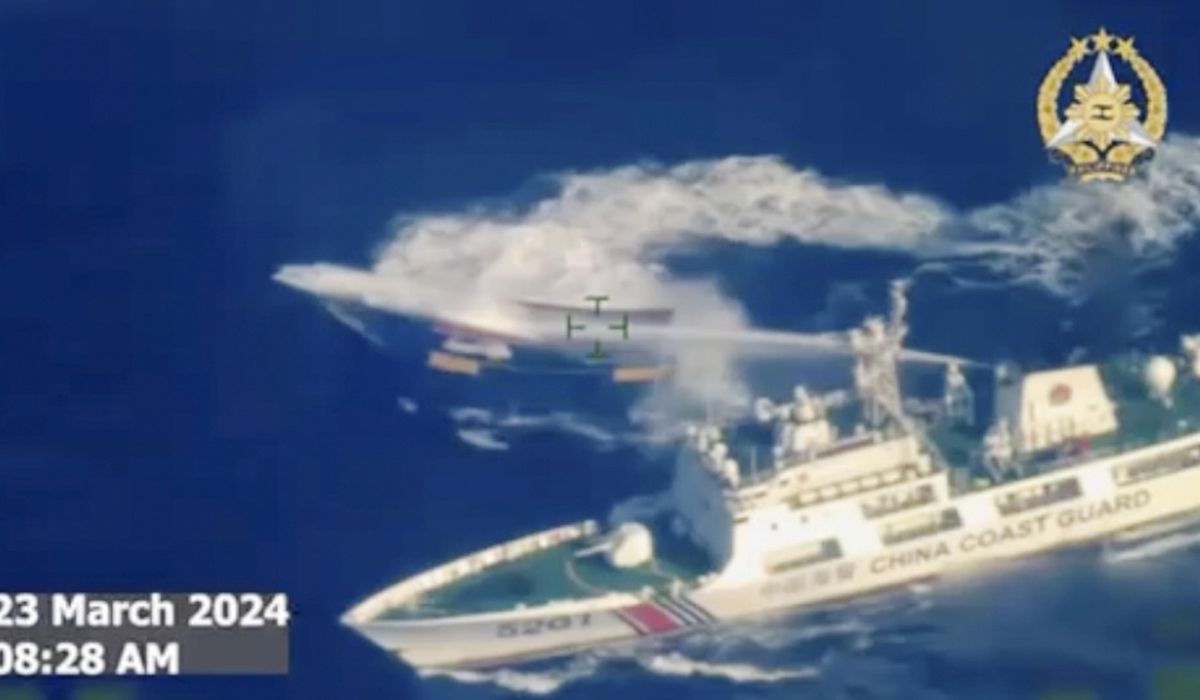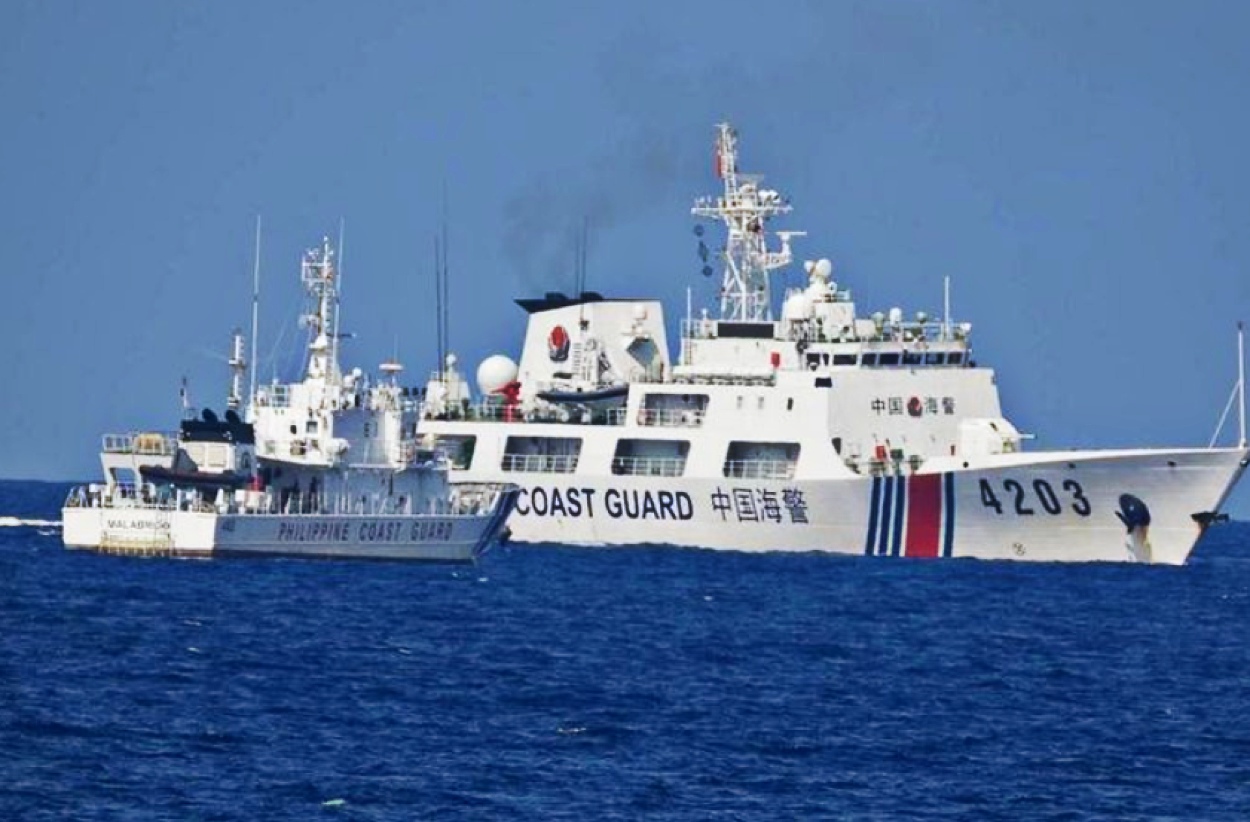For the first time, Japan will participate actively in a tri–nation patrolling exercise in the South China Sea region, a hotbed of tension between China and the Philippines, along with the US and the Philippines.
The United States, along with its allies, Japan and the Philippines, is geared up to kick off joint patrols in the Indo-Pacific region in response to what the allies refer to as China’s aggressive and expansive moves making up its ’grey zone tactics.’
As Politico recently reported, the trilateral patrols are part of a “package of initiatives” that the Presidents of the three nations will announce at their first-ever summit on April 11. However, none of the parties have acknowledged these claims.
The reports also noted that the three heads of state — Joe Biden, Fumio Kishida, and Ferdinand R. Marcos Jr.– will sign an agreement on trilateral cooperation along the lines of a similar arrangement between the US, Japan, and South Korea. EurAsian Times could not independently verify these claims.
The development, nonetheless, comes as tensions continue to escalate between China and the Philippines in the disputed territories in the South China Sea. Although there have been frequent engagements between the two sides, matters came to a head last month when a Chinese Coast Guard vessel assaulted a Filipino boat with water cannons, injuring the crew onboard.

The Philippines has since lodged a strong protest with China, which has become increasingly belligerent since 2023, regularly obstructing Filipino vessels on a mission to reinforce the Sierra Madre military outpost in the Second Thomas Shoal.
Since last year, there have been several encounters on the high seas that have raised concerns about the possibility of a broader clash that might put China and the US on a collision course. The United States has frequently warned that if Filipino forces, ships, or aircraft are subjected to an armed attack, including one in the South China Sea, it will have to defend the Philippines, its oldest treaty partner in Asia.
In response to China’s aggression in the South China Sea, the Philippines and the US have undertaken several joint patrols since November 2023. However, this will be the first time the Japanese Maritime Self-Defense Force participates in such an exercise. The drills are expected to start as soon as possible, the Japanese publication Asahi Shimbun reported.
The Japanese media report also highlighted that the country intends to elevate the Philippines to the position of “quasi-ally,” a status currently accorded to Australia and Britain. EurAsian Times had previously reported that the Philippines was seeking a stronger military pact with Japan with an anticipated signing of a military agreement between them (Read the in-depth coverage here).
🇵🇭 & 🇺🇸 ships in the South China Sea: BRP Conrado Yap, USS Gabrielle Giffords, and USNS John Ericsson conduct a Joint Maritime Patrol during the 🇵🇭🇺🇸 Maritime Cooperative Activity. The 🇵🇭 corvette and the 🇺🇸 Littoral Combat Ship linked up in the Luzon Strait on Tuesday night. pic.twitter.com/m8ThoFRFS8
— Aaron-Matthew Lariosa (@Aaron_MatthewIL) November 23, 2023
Allies such as the United States have supported Manila amidst the escalating tensions. However, since Japan is closer, developing a more intimate friendship with Tokyo makes sense. More, China has emerged as a common adversary for both Manila and Tokyo, with the latter feeling uncomfortable as it threatens Taiwan’s government.
As for the United States, both the Philippines and Japan sit at very crucial and strategic locations in the region to counter China. In recent years, Washington has demonstrated a penchant for forming small multilateral groupings to take on the burgeoning Chinese military power in the Indo-Pacific, and its “grey zone tactics” which are essentially coercive Chinese measures undertaken over a long period to weaken its adversaries.
Coast guard ships from US, Japan and Philippines hold law enforcement drills in waters near the disputed South China Sea amid increased tensions with Beijing pic.twitter.com/XWNJFKFO94
— RT (@RT_com) June 6, 2023
Last year, the three countries dispatched their coast guard ships to stage law enforcement drills in waters near the disputed South China Sea. “We are not just all display,” Philippine Coast Guard Deputy spokesperson John Ybanez said at that time. “All these exercises that we do will help us help each other in possible scenarios in the future.”
The prospect of Japan joining the joint patrols has left China fuming, with its state-owned publication, Global Times, lambasting the reports.
China Unhappy
The Global Times report said the relationship between Japan and the United States is “evolving into an axis of evil.” It noted in no ambiguous terms that the United States was “encouraging the Philippines to incite chaos in the South China Sea.”

The report also referred to the remarks made by the Commander of the United States Indo-Pacific Command, Admiral John Aquilino, to emphasize that the US was inciting trouble in the region. Aquilino had recently said, ” The Philippines, if a sailor or soldier, or one of their members were killed, could invoke Article 5 of the Mutual Defense Treaty.”
Responding to the trilateral joint patrol reports, Chinese analysts also cautioned that the US-planned and supported exercises in the South China Sea will only exacerbate the crisis and conflicts in the western Pacific, giving the US an advantage over China, securing its position as the leader among its allies, and profiting from the chaos in the same way that it did in Europe.
Days Patrolled by #China's Coast Guard in 2023
The China Coast Guard is central to Beijing's efforts to assert control over their vast maritime claim in the #SouthChinaSea
See AMTI's full data on their 2023 activity in the link: ⬇️https://t.co/Er5olJNLnY pic.twitter.com/kdExthEdSA
— Indo-Pacific News – Geo-Politics & Defense (@IndoPac_Info) March 29, 2024
Ding Duo, the deputy director of the Institute of Maritime Law and Policy at the China Institute for South China Sea Studies, said that the joint patrols carried out by the three nations in the South China Sea, along with their political cooperation, have surely contributed to the worsening of the regional security situation.
He noted that they are unmistakably destabilizing elements that represent a certain risk to China’s security. “The provocative behavior of the US, Japan, and the Philippines in the vicinity of the South China Sea demonstrates the characteristic of ‘originating from the US, with Japan’s cooperation, and the Philippines’ eager compliance.’
Additionally, a Chinese navy flotilla of the Southern Theater Command of the People’s Liberation Army (PLA), composed of warships including the Xueshan and Lushan, conducted high-intensity and multi-course real combat training in the South China Sea. The drills targeted a variety of targets at sea and in the air, such as an enemy jet and an armed fishing boat. Beijing has seen the drills as a warning.
The purpose of the cross-day-and-night exercises, according to the Command, was to evaluate commanders’ and troops’ capacity for emergency response, their practical weapon handling skills, and their command coordination in challenging combat situations.
The experts noted that the PLA drills likely sent a strong message that the PLA will remain on high alert, regardless of combined patrols or other activities by the US, Japan, and the Philippines.
- Contact the author at sakshi.tiwari9555 (at) gmail.com
- Follow EurAsian Times on Google News




